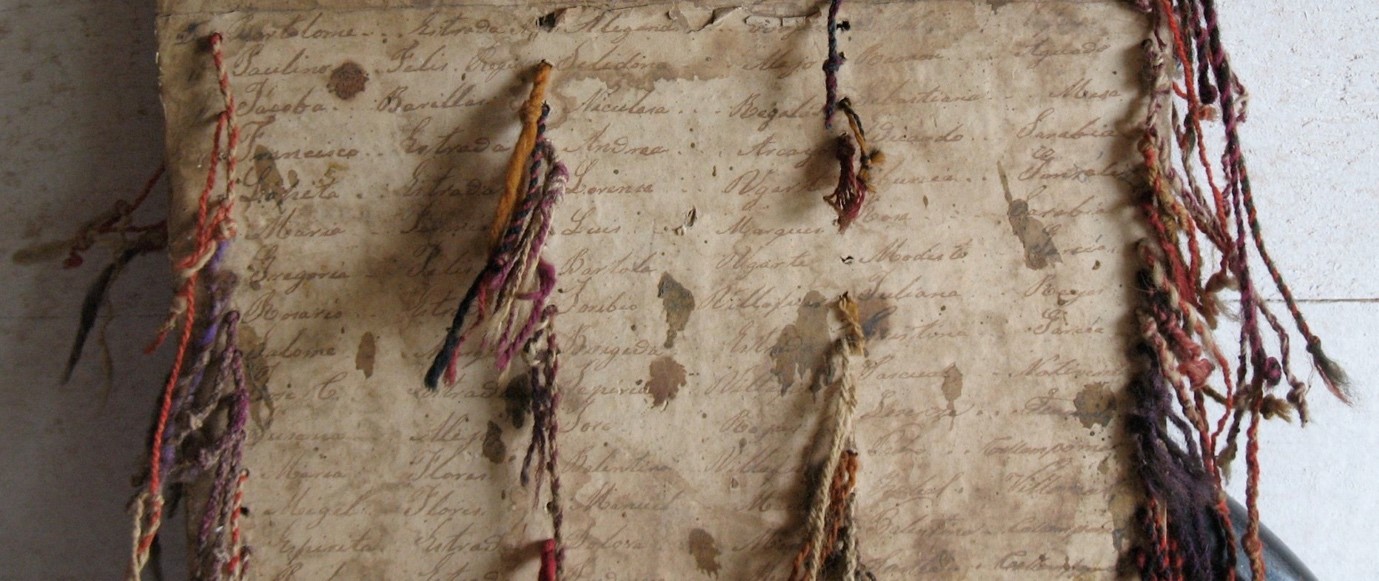Drawing on interdisciplinary methods and techniques, Maria Koulouri in the Department of Social Anthropology has developed the first digital record of the Mangas Khipu Board, helping further decipher the context and meanings of Andean Khipu records and make them more accessible to people around the world.
Khipu is a record system of strings and knots used by the Indigenous peoples of Peru, primarily during the Late Horizon of the Inka (c. 1400 – 1538 AD). Dr Sabine Hyland of the School of Divinity, a leading expert in ethnographic Khipu, has discovered a hybrid Khipu Board in the community of Mangas. The Mangas Khipu Board recorded contributions of labour and goods that certain individuals were expected to provide in major community ceremonies and was reused for at least 100 years since the 1800s.
The Mangas Khipu Board. Photo credit: Sabine Hyland.
Maria Koulouri digitised the artifact using measurement data of the artefact collected by Dr Hyland. Koulouri fully coded the dataset and applied advanced statistical analysis to fully decipher all the signs present on the pendants of the Board. She also used ethnographic data (ethnoarchaeology: understanding material culture in today’s natural settings, and ethnomethodology: understanding Indigenous and endogenous methods) gathered from the community of San Pedro de Casta in Lima.
She has since built on Dr Hyland’s work on the associations between knot direction and social groups. The research explains why people on the Board who have the same family name exhibit different knot directions, something that was not entirely understood before. Maria’s research also highlights how non-hierarchical multilevel structures (multiple membership and cross-classifications) are embedded on Khipu records by colour. This was accomplished using a combination of classification techniques and multilevel modelling theory on the digitised datasets of the Khipu Board.
Koulouri’s research on the Mangas Khipu Board has provided further insight into the historical context of Khipu communication as well as the Board itself. She has discovered that visual features of the Khipu cords resemble those of pre-Inka traditions. This indicates that local Andean communities most likely kept their own artistic preferences during the Inka period, highlighting a sense of distinct cultural identity.
The community-centred focus of Koulouri’s research and her use of diverse forms of inclusive community engagement as research methods, speak to the power of this project to not only provide further insight into a historical mystery, but empower and involve communities in the discovery of their cultural heritage. Following in the path of wider decolonization efforts – including Professor Hyland’s plans to work with the community of Mangas to house the Khipu Board at a local museum – one of Koulouri’s major goals is to render the Mangas Khipu Board accessible to anyone who wants to learn more. Dating back to the Inka period, Khipu artefacts were historically managed by a small circle of experts (Khipucamayoqs), and knowledge of Khipu has continued today to be relegated to a limited class of academics (who care to preserve this heritage) and elite institutions (centralised museums). Koulouri hopes to widen that access, from university students in Scotland to pupils in the Andes, who can use this digital record as an educational tool to learn ethnomathematics and understand more about Andean history through their very own material heritage. Her research is consequentially providing Andean local communities with sustainable social, economic, and cultural capital through digital preservation of this unique Khipu artefact.
This blog post was written by Ishani Khemka and Victoria Lee


